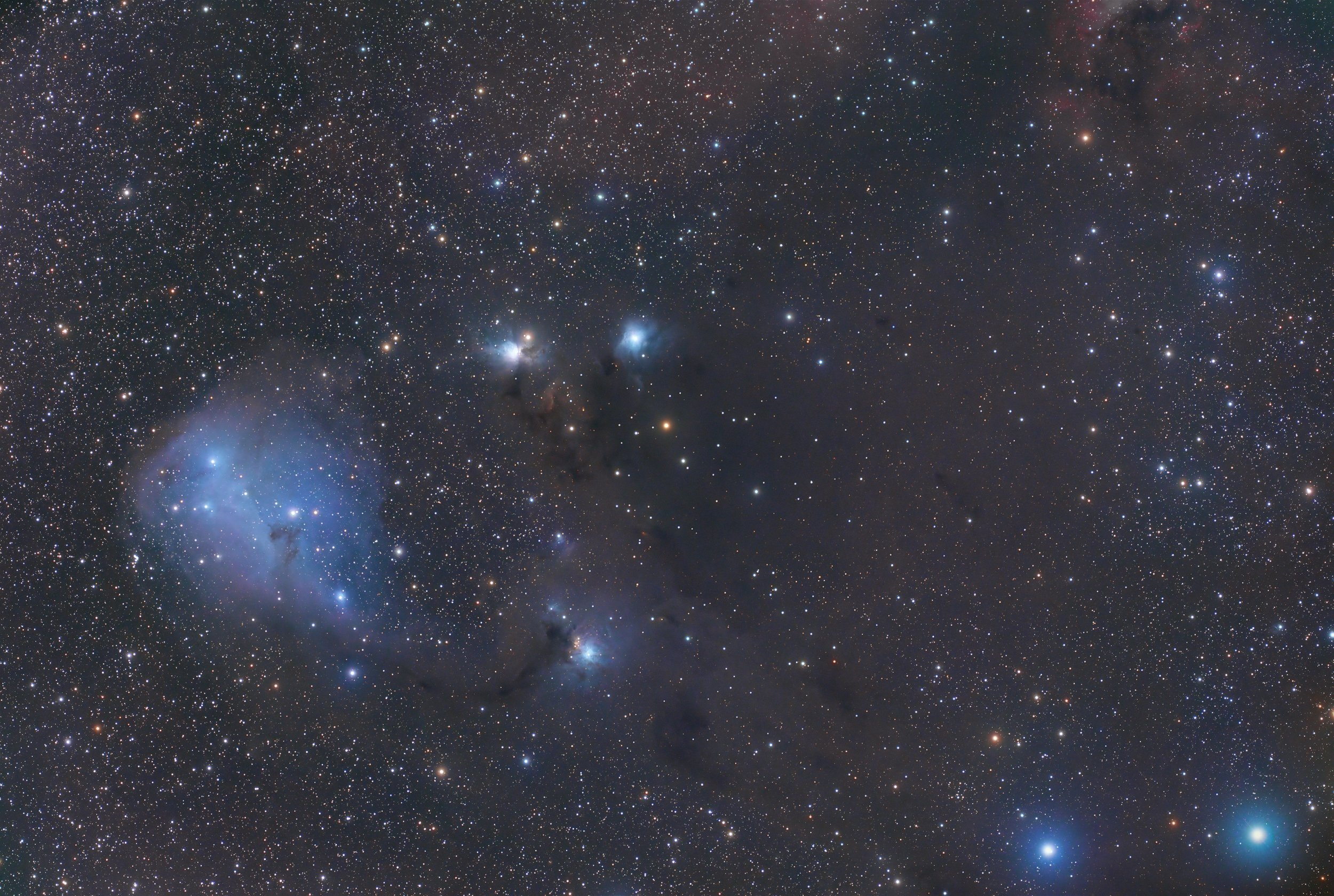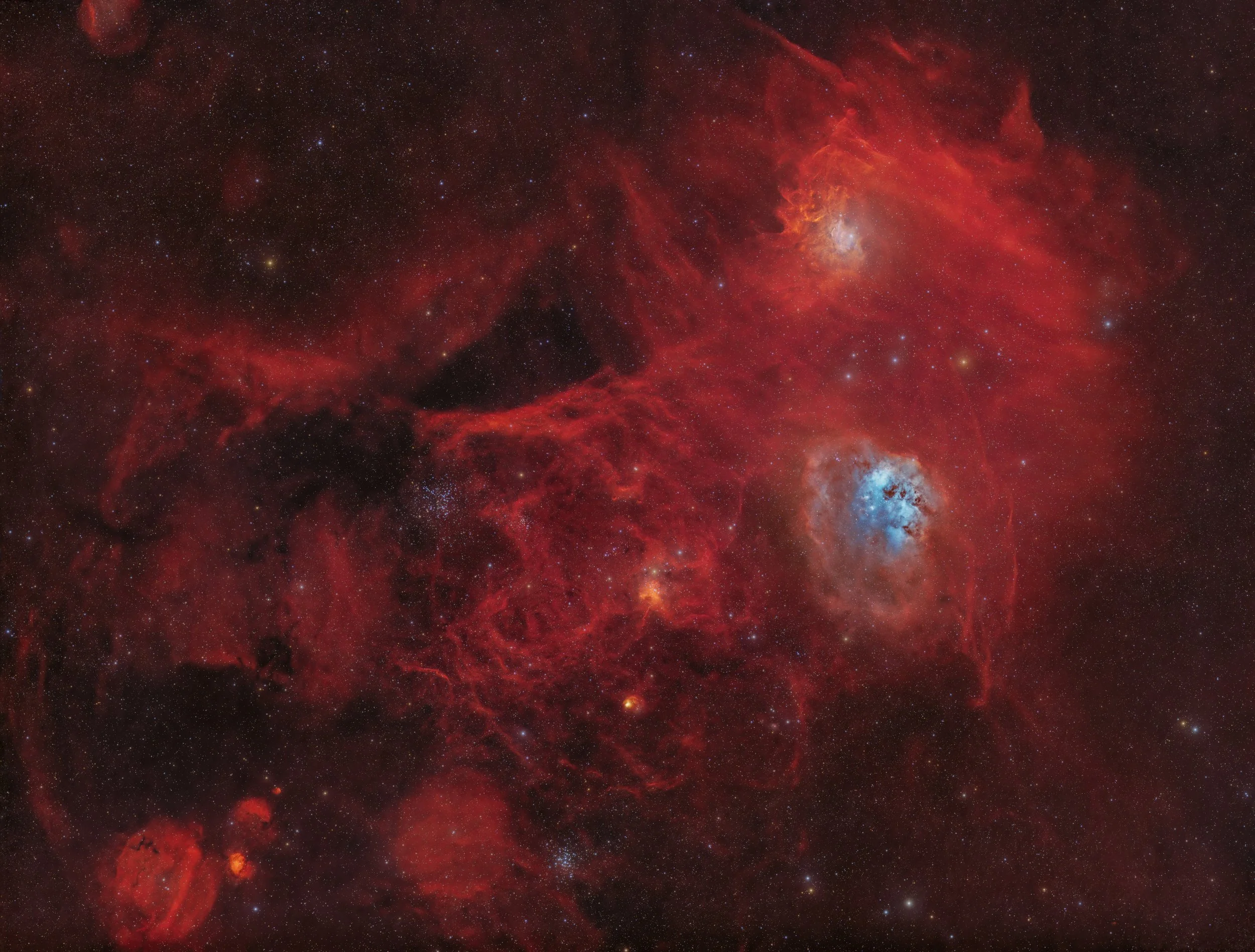
AAPOD2 Image Archives
Fleeting Giant – Solar Prominence
This image captures a towering solar prominence in rapid evolution—an immense arc of plasma extending from the Sun’s limb and suspended by magnetic fields. Estimated to reach a height of around 150,000 kilometers, the prominence appeared suddenly and vanished within minutes, a dramatic display of solar dynamics unfolding in real time.
Such prominences are composed of relatively cool, dense plasma compared to the surrounding corona and are often associated with solar flares and coronal mass ejections. This fleeting structure, visible only for a short time, is a powerful reminder of the ever-changing and energetic nature of our Sun.
The Whale
This deep-space portrait features NGC 4631, commonly known as the Whale Galaxy—a striking edge-on spiral galaxy located about 30 million light-years away in the constellation Canes Venatici. Its elongated shape and subtle warp resemble a breaching whale, while surrounding star fields and faint galactic structures hint at past gravitational encounters, particularly with its smaller companion, NGC 4627.
Captured over three nights in March 2025, this image combines 16 hours and 30 minutes of data using a remote 8-inch reflector telescope and a cooled monochrome camera, paired with both broadband and narrowband filters from @starfront_observatories. The result is a richly detailed view of this elegant galactic swimmer in a sea of stars.
The sickle of Venus in broad daylight
This rare and delicate capture reveals Venus as a slender crescent—often called the "sickle of Venus"—gleaming in the blue midday sky. As Venus approaches inferior conjunction, it draws closer to Earth and appears larger in size but increasingly illuminated as a thin arc. Capturing this fleeting phase in daylight requires precise timing, careful planning, and excellent atmospheric conditions.
Photographed in broad daylight, this image highlights the fascinating interplay of light, phase, and geometry in our inner planetary neighbor. It’s a reminder that with the right tools and patience, the wonders of the cosmos can reveal themselves even under the Sun’s glare.
NGC4151 the "mini-Quasar and cie
This superb wide-field image reveals a fascinating concentration of galaxies located in the constellation Canes Venatici, approximately 60 million light-years from Earth. Among the celestial protagonists of this deep field are NGC 4145, NGC 4151, and NGC 4156, alongside a multitude of more distant galaxies that dot the sky like a veritable carpet of extragalactic stars.
NGC 4151 — The Star of the Field
Sometimes nicknamed the "mini-Quasar," NGC 4151 is one of the most studied active Seyfert galaxies. Its nucleus is particularly luminous due to the presence of a supermassive black hole of approximately 40 million solar masses, which is currently engulfing matter. This process generates intense radiation that extends from the radio to X-ray range. Located approximately 62 million light-years away, NGC 4151 is often considered a natural laboratory for the study of active galactic nuclei (AGN).
NGC 4145 — A Disturbed Spiral
Slightly lower in the image, NGC 4145, a barred spiral galaxy, can be seen face-on, with its arms slightly distorted by gravitational interactions. This irregular structure could be the result of past encounters with small satellite galaxies. Located approximately 45 million light-years away, it harbors star formation activity in its arms, which is indicated by a bluish hue.
NGC 4156 — Small but Not Inconspicuous
Right next to NGC 4151, the small NGC 4156 is an elliptical or lenticular galaxy. Although it appears modest in size, it is likely part of a group of interacting galaxies. Its diffuse halo indicates a turbulent history, potentially marked by minor mergers with other galaxies.
Regulus and Leo 1 Galaxy
In this striking image, the brilliant star Regulus dominates the frame, casting its radiant light across the Leo constellation. Regulus, the brightest star in Leo and one of the brightest in the night sky, is a massive, rapidly rotating blue-white star located about 79 light-years from Earth.
To the lower left of Regulus lies a subtle but fascinating feature: Leo I, a faint dwarf spheroidal galaxy that is a satellite of the Milky Way. Though easily washed out by the glare of Regulus, careful processing reveals this distant and dim galaxy, lying roughly 820,000 light-years away. Its ghostly appearance offers a glimpse into the quiet companions of our galaxy—faint systems full of ancient stars and dark matter.
Capturing both a dazzling foreground star and a barely-there galaxy in the same field requires meticulous planning and expert imaging technique, making this a beautifully executed and scientifically rich observation.
NGC 4236 — A Subtle Spiral in the Heart of Draco
NGC 4236 is a faint, barred spiral galaxy nestled within the constellation Draco, approximately 11.7 million light-years from Earth. Though less luminous than many of its spiral cousins, this galaxy stretches impressively across nearly 200,000 light-years—making it even larger than the Milky Way. Its low surface brightness and diffuse structure make it a challenging target for astrophotography, especially from less-than-pristine skies, but those who capture it are rewarded with delicate filaments of star-forming regions and hints of graceful spiral arms.
Classified as an intermediate spiral, NGC 4236 resides in the M81 galaxy group but appears to have evolved in relative isolation, which may explain its subdued appearance and scattered star clusters. Within its softly glowing disk, regions of H-alpha emission betray sites of ongoing stellar birth, offering insight into how galaxies can sustain slow but steady star formation even in quieter cosmic neighborhoods.
Core of the Orion Nebula
At the heart of Messier 42—the Orion Nebula—lies a turbulent stellar nursery just 1,350 light-years away, where gas and dust swirl in a chaotic dance of creation. This image captures the nebula’s intensely bright core, a high-dynamic-range composition that preserves both the brilliant Trapezium star cluster and the dim, sculpted tendrils of ionized hydrogen and oxygen. The Trapezium’s fierce ultraviolet radiation carves and illuminates the surrounding gas, shaping cavities and jets from newly forming stars buried within the nebula.
Far from a static scene, the core of Orion is a theater of evolution. Stellar winds, shock waves, and magnetic fields drive a cycle of destruction and creation, with infant protostars still forming within cocoons of dust. Hidden within this brightness are features such as proplyds—planetary systems in the making—offering an unparalleled view into the conditions that may mirror our own solar system’s beginnings.
Omega Centauri
Omega Centauri (NGC 5139) is the largest and brightest globular cluster visible from Earth, lying approximately 17,000 light-years away in the constellation Centaurus. Spanning more than 150 light-years in diameter, it contains an estimated 10 million stars—many of which are ancient, dating back over 12 billion years. Its sheer size, mass, and stellar diversity set it apart from typical globular clusters, suggesting it may be the remnant core of a dwarf galaxy long ago absorbed by the Milky Way.
This densely packed stellar sphere dazzles in long-exposure images, revealing its layered population of red giants, blue stragglers, and faint white dwarfs. Its dense core is a prime subject of study for astronomers seeking clues about early galactic formation. Observing Omega Centauri from the dark skies of Río Hurtado offers a breathtaking glimpse into a relic of the early universe still orbiting silently in our galactic halo.
NGC 4631 - Whale Galaxy
NGC 4631, often called the Whale Galaxy due to its elongated, fish-like profile, is a stunning edge-on spiral galaxy located about 25 million light-years away in the constellation Canes Venatici. Spanning roughly 140,000 light-years, it's slightly larger than our Milky Way and teems with star-forming regions that radiate brightly in ultraviolet and hydrogen emissions. Its thick, warped disk and bright central bulge create the illusion of a breaching whale gliding through the cosmos.
This galaxy is also notable for its strong halo of hot gas visible in X-ray and radio wavelengths—a signature of vigorous star formation and stellar winds pushing material far above the galactic plane. NGC 4631 is gravitationally interacting with its nearby companion, NGC 4627, a dwarf elliptical galaxy, which may be partially responsible for its distorted shape and turbulent starburst activity. Together, they form an intriguing and photogenic duo in the deep sky.
First Quarter Mineral Moon
This striking image captures the Moon at its first quarter phase, enhanced with a mineral color treatment to reveal subtle variations in surface composition. The blue and brown hues represent differences in the Moon’s geological makeup—blues indicating titanium-rich areas and browns marking regions with lower titanium and higher iron content. Craters and mare basins come to life with added depth and contrast, offering a fresh perspective on our familiar satellite.
Photographed from Shropshire, England, this mineral Moon image showcases how modern processing techniques can turn a classic lunar phase into a visually stunning and scientifically rich portrait.
Auriga's Heartbeat: Nebulae and an Ancient Cluster
his vibrant wide-field image captures two prominent emission nebulae in the constellation Auriga: the Flaming Star Nebula (IC 405) and the Tadpole Nebula (IC 410). IC 405 glows with the intense light of the hot star AE Aurigae, which energizes surrounding hydrogen gas, creating a fiery appearance. Nearby, IC 410 houses the "tadpoles"—dense, dusty structures sculpted by stellar winds from the young cluster NGC 1893.
The image combines over 20 hours of integration using both narrowband and broadband filters. The result is a richly detailed view blending structure, color, and contrast—highlighting the dynamic interplay of ionized gases and star formation within these celestial clouds.
Galaxies from Near to Far: NGC 3718, NGC 3729 to Hickson 56 and Beyond
This deep-space composition reveals a stunning cosmic lineup beginning with the warped spiral galaxy NGC 3718 and its companion NGC 3729, just 52 million light-years away in the constellation Ursa Major. Their distorted shapes hint at gravitational interactions, setting the stage for a layered journey into the depths of space. Just beyond lies Hickson Compact Group 56, a tight cluster of interacting galaxies over 400 million light-years away, their faint forms whispering of ancient mergers and galactic drama.
Captured from Wunstorf, Germany, this image spans an extraordinary range of distances and cosmic time. From relatively nearby neighbors to remote galaxy groups, it provides a rare visual bridge across the universe, reminding us how interconnected—and immense—our cosmic neighborhood truly is.
Rosette Nebula core
This captivating image highlights the central region of the Rosette Nebula, a vast star-forming area in the constellation Monoceros. The nebula's core reveals intricate gas structures, bathed in the intense light of young stars. The detailed image was captured through 24 light frames, each a 5-minute exposure, and demonstrates the beauty of this stellar nursery despite the challenges posed by light pollution.
Captured using a personal telescope setup, the image was taken with a Sky Watcher Wave 150i mount, Celestron 8 EdgeHD optics, and a ZWO ASI2600MC Air camera, paired with an Antlia Quad Band Anti-Light Pollution Filter. The combination of advanced equipment and careful data acquisition reveals the delicate complexity of this cosmic wonder, offering a stunning view of the Rosette Nebula's vibrant core.
4o mini
Leo Quartet/ Hickson 44
Hickson 44, also known as the Leo Quartet, is a compact galaxy group located approximately 80 million light-years away in the constellation Leo. This interacting system consists of four prominent galaxies: NGC 3190, NGC 3193, NGC 3187, and NGC 3185. NGC 3190, the brightest and most striking member, is a warped spiral galaxy with a prominent dust lane cutting across its disk. Nearby, NGC 3187 showcases distorted spiral arms, a sign of gravitational interactions, while the elliptical NGC 3193 remains relatively undisturbed. The smallest of the group, NGC 3185, exhibits a faint barred spiral structure.
These galaxies are in the process of a slow cosmic dance, their mutual gravitational forces shaping their evolution over millions of years. Hickson 44 is an excellent example of galaxy interactions influencing star formation, structural distortions, and potential future mergers. Deep exposures reveal faint tidal streams and extended halos, evidence of past interactions that continue to shape this fascinating galaxy group.
M63 – The Sunflower Galaxy
M63, also known as the Sunflower Galaxy, is a striking spiral galaxy located about 27 million light-years away in the constellation Canes Venatici. This galaxy is a member of the M51 Group and exhibits a flocculent spiral structure, characterized by numerous short, patchy spiral arms rather than well-defined grand design arms. These star-forming regions, rich in young, blue stars, give M63 its distinctive, textured appearance, resembling the pattern of sunflower petals.
A faint, extended halo of stellar streams surrounds the galaxy, remnants of past interactions with smaller satellite galaxies. Observations in infrared and ultraviolet wavelengths reveal ongoing star formation throughout the disk, while deep imaging unveils a complex structure shaped by tidal forces. M63’s active core and vast star-forming regions make it a fascinating target for astrophotography and a valuable object for studying galaxy evolution.
NGC 3169: A Cosmic Dance of Gravitational Tides
NGC 3169 is a striking spiral galaxy located approximately 70 million light-years away in the constellation Sextans. Unlike the classic symmetrical spirals, this galaxy exhibits pronounced distortions in its arms, likely due to gravitational interactions with its neighboring galaxy, NGC 3166. These tidal forces have stretched its outer arms, creating a visually dynamic structure filled with dust lanes and star-forming regions.
This image reveals the intricate details of NGC 3169’s spiral arms, which host young, hot blue stars, while its core glows with the golden light of older stellar populations. A prominent dust lane bisects the central bulge, indicating active star formation and turbulence. The galaxy’s active nucleus, powered by a supermassive black hole, emits faint but detectable emissions across multiple wavelengths, suggesting ongoing accretion activity.
The Rosette Nebula in SHO – A Stellar Bloom
The Rosette Nebula (NGC 2237) is a vast emission nebula located in the constellation Monoceros, approximately 5,200 light-years from Earth. This stunning region of ionized hydrogen glows due to intense ultraviolet radiation from the young, hot stars of its embedded open cluster, NGC 2244. The radiation and stellar winds from these massive stars have sculpted intricate structures within the nebula, creating a cosmic “flower” spanning over 130 light-years.
Captured in the SHO Hubble Palette over 37 hours of integration time, this image reveals the nebula’s complex interplay of gases. The sulfur (SII) emissions appear in red, hydrogen-alpha (Ha) in green, and oxygen (OIII) in blue, highlighting delicate filaments and shock fronts. The deep exposure brings out the faintest wisps of nebulosity, while the central cavity—carved by stellar feedback—stands as a testament to the dynamic life cycle of massive stars.
Shadows and Peaks Along Alpine Valley
This high-resolution lunar image showcases the dramatic contrast between shadowed and sunlit terrain along the terminator, revealing an intricate interplay of impact history and geological evolution. The dominant crater Aristoteles, a 3.8-billion-year-old impact structure, stands out with its terraced walls and central peak, while the neighboring Eudoxus adds to the rugged topography. Below, the Cassini crater, partially flooded by ancient lava, marks the transitional boundary between the rough highlands and the smooth plains of Mare Imbrium. The rugged Lunar Alps stretch across the frame, with the sinuous Alpine Valley cutting through them—a rift possibly formed by tectonic forces or subsurface magma movement. This image is a striking testament to the Moon’s violent past and the forces shaping its ever-scarred surface.
RCW-58 Cosmic Flower
RCW 58 is a striking emission nebula surrounding the Wolf-Rayet star WR 40, located in the constellation Carina. This nebula is a stellar wind-blown bubble formed by the intense radiation and powerful outflows from WR 40, a massive, evolved star nearing the final stages of its life. The surrounding filaments and arcs of ionized gas are the remnants of material ejected by the star in previous evolutionary phases, shaped by its violent stellar winds.
Wolf-Rayet stars like WR 40 are rare and extremely hot, with surface temperatures exceeding 100,000 K. Their strong winds create intricate nebular structures such as RCW 58, which glows brightly in hydrogen-alpha (Hα) and oxygen-III (OIII) emissions. These regions serve as laboratories for studying the late evolution of massive stars before they ultimately end their lives in a supernova explosion. Observing RCW 58 in narrowband filters reveals detailed shock structures and interactions between the ejected material and the surrounding interstellar medium, offering insight into the final turbulent stages of stellar evolution.
partial solar eclipse
On March 29, 2025, a partial solar eclipse will grace the skies, visible primarily across parts of North America, Europe, and northern Asia. During this event, the Moon will pass between the Earth and the Sun, obscuring a portion of the solar disk and creating a dramatic crescent shape. Unlike a total solar eclipse, where the Moon completely blocks the Sun, a partial eclipse leaves a sliver of sunlight visible, making the event a dazzling but less intense phenomenon.
The magnitude and duration of the eclipse will vary depending on location, with the greatest obscuration occurring in northern latitudes. Observers will witness a noticeable dimming of daylight, and if conditions are clear, solar viewers or eclipse glasses will allow safe observation of the event. Partial solar eclipses provide an excellent opportunity to appreciate the celestial mechanics of our solar system and remind us of the dynamic relationship between the Earth, Moon, and Sun.





















